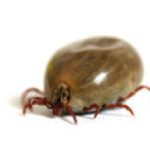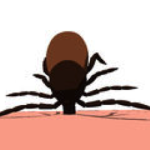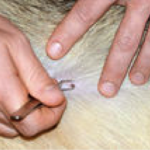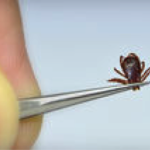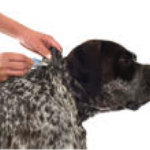Hello.
This time I’m going to write about ticks. You know those flat little blood-suckers that attach, suck your blood, engorge up and fall off? They give me the creeps.
But this is tick time of year. I want to talk to you about ticks: what they do and what you can do about them.
This is what I know…
Ticks, otherwise known as wood ticks, are small little arachnids that hang out on the long grasses and branches in the spring and summer waiting to catch a ride. When your dog or cat brushes by the little bug, it jumps right on. Then the tick travels to somewhere warm on the animal’s body. Ticks like the head and neck area, as there is a lot of warmth and good blood supply.
They latch on with special mouth parts and start sucking blood. Eeeww!
Well, other than the gross factor, what harm do ticks do?
Transmission of Disease
The most common tick in our area, the East Kootenays, is the wood tick, also called Dermacentor andersoni. This tick does not carry Lyme disease, but it can carry some toxins that cause “Tick Paralysis”. This disease causes extreme weakness and paralysis in pets and livestock, but the signs go away once the tick is removed.
The tick that carries Lyme disease, an Ixodes tick, is very rare in this area.
There are other blood-borne diseases that ticks can carry, although they are quite rare. If you notice your dog or cat is ill and you know he has had a recent tick bite or still has a tick, always take your pet in to the veterinarian. If there are no signs of illness or weakness, get busy and remove that tick!
How to Remove a Tick from your pet
Removing ticks can be tricky. Try to remove the tick with tweezers, grabbing the tick as close to the head as possible and pulling with gentle pressure. If you don’t get all of the mouth parts the first time, don’t panic: get out as much as you can and your pet’s immune system will take care of the rest. You can always consult your veterinarian if you’re still concerned.
Don’t use a flame or a hot poker on the tick; you’ll only end up burning your pet’s fur or skin.
Ticks have very hard body shells, so if you’re trying to kill the tick sometimes just stepping on it isn’t enough. You have to squish them very hard or separate the head from the body in order to kill them.
How to prevent ticks from biting your pet
There are medications that will kill ticks once they start sucking blood. There are also treatments that repel ticks and prevent them from biting in the first place. These anti-parasite treatments are usually given topically and used once a month. There are also new flea and tick collars that are useful to prevent the ticks from settling down to bite and suck blood.

Some of these treatments are very poisonous to cats, so be sure you talk to your veterinarian first and read all labels.
A chemical free way to deal with ticks is to check your cat or dog every day. Look carefully around the head and neck, part the hair, comb through and look for the un-engorged tick so you can stop it before it bites.
Avoiding long grasses and keeping your own yard mowed and free from leaves and weeds will help keep ticks at bay.
Well, I think we all agree on how much we don’t like ticks and don’t ever want to see one latched on to our bodies. Not cats, not dogs, not people, no one. But if you find one … be brave and just deal with it!

